Smith: Rescued after multiple jumps from their nest, rare barn owls get second chance at life in the Wisconsin wild
ANTIGO - Marge Gibson carefully cradled the juvenile barn owl and looked into its eyes.
"You are just perfect," said Gibson, a licensed wildlife rehabilitator and executive director of Raptor Education Group Inc. in Antigo.
Extremely rare, too.
Among the many hundreds of Wisconsin-bred wild animals REGI takes in this year, none will be more rare than the two barn owls it received in June.
In fact the birds, a male and a female, were from the only known barn owl nest in the state.
The cavity in the big, dead, silver maple gained notoriety in 2021 when it hosted the first barn owl nest documented in Wisconsin in 20 years, said Ryan Brady, conservation biologist with the Department of Natural Resources.
This year adult barn owls used the western Wisconsin site again, producing at least three hatchlings.
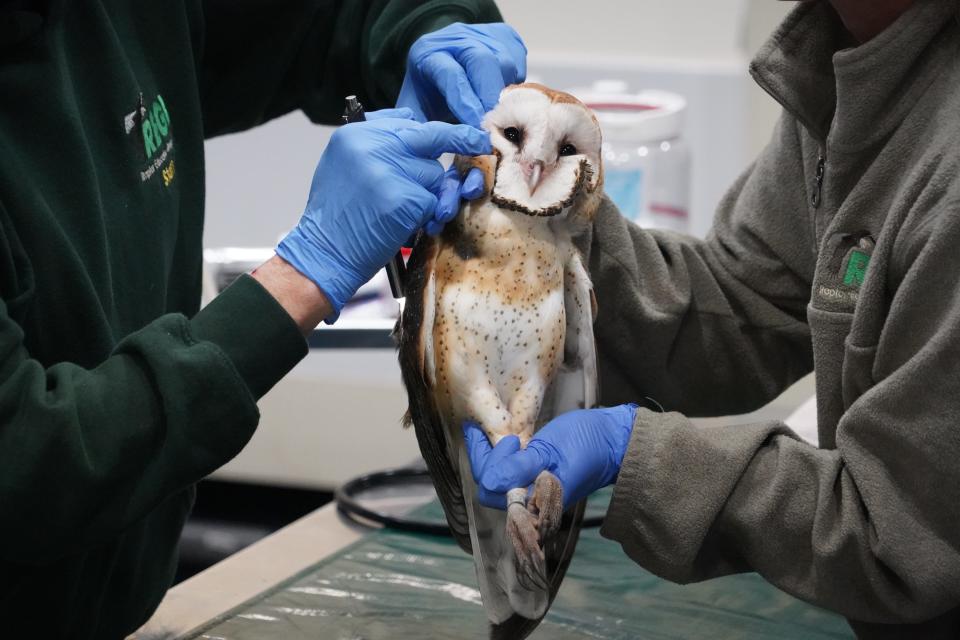
But in early June owners of the private property found two young barn owls on the ground beneath the tree.
They called in experts, including Karla Bloem, executive director of the International Owl Center in Houston, Minnesota; Laura Johnson, a veterinarian who works out of Prairie du Chien; and staff at the Coulee Region Humane Society in Onalaska.
Despite repeated attempts to return them to the nest, the birds kept jumping out, perhaps because they were pestered by black flies.
Enough was finally enough.
"They weren't going to stay (in the nest)," said Bloem, who had installed a remote camera to observe activity in the tree cavity. She confirmed the presence of a problematic number of black flies as well as continued attempts by the adults to feed the young.
But since they kept jumping and were deemed underweight, in early June the two owlets were transported to REGI.
The rare birds had no way of knowing their good fortunes.
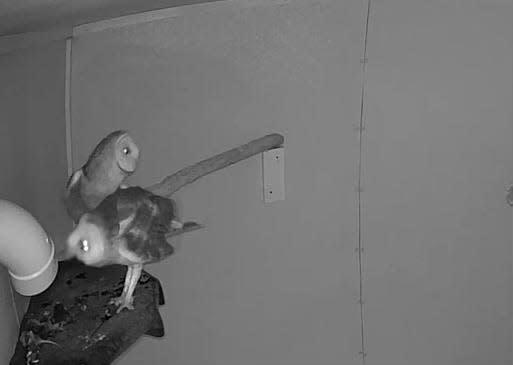
The Antigo rehab facility has an adult European barn owl in its flock of unreleasable birds.
The European barn owl took over foster parent duties for several weeks until the young birds could eat on their own.
"I know it sounds simple, but you can't overemphasize how important it is for their future life in the wild that they learn to be barn owls from another barn owl," Gibson said.
The young barn owls were kept together in an outdoor flight enclosure at REGI; to avoid contact with humans, food (mostly mice) was placed inside via a trap door.
Barn owls can be identified by their unique, white, heart-shaped face.
Their head, back and upper wings are a mix of buff and gray while their face, body and underwings are white. The species lacks ear tufts seen in other familiar owls.
An adult barn owl weighs about 1 pound, stands about 15 inches high and has a wing span of about 3 feet.
Since they are almost entirely nocturnal and rarely call, they are not easily seen or documented by birders.
Among the species' impressive abilities: It hunts entirely on the wing and relies almost exclusively on its outstanding hearing to locate prey.
A common hunting scenario is a barn owl flying at night over grasslands, turning abruptly and plunging down to grab a mouse or other rodent, Bloem said.
Barn owls typically nest and roost in tree cavities, abandoned barns and buildings. They are also one of the most widespread birds in the world and have been documented on all continents except Antarctica.
They are mostly found in more southerly latitudes in North America so historically the species was present but uncommon in Wisconsin.
Numbers in the state declined by the 1980s and the species was put on the state endangered species list.
Only three barn owl nests were detected during the first Wisconsin Breeding Bird Atlas field survey from 1995 to 2000, the last in Grant County in 1999, according to the DNR.
Sightings were few and no nests were detected for many years, leading the DNR to remove the barn owl from the state endangered species list in 2014 for a lack of records.
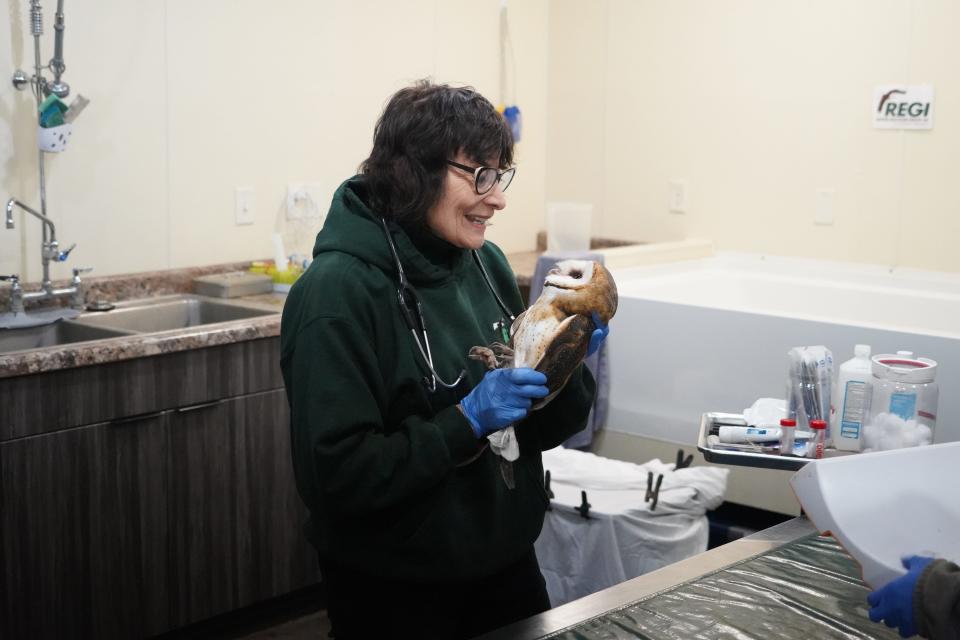
Soon after, nest box programs that help maintain critical nesting habitat in Iowa, Illinois and Indiana began to see a slight increase in barn owls.
As more barn owls were produced, some moved into Wisconsin and sightings started to pick up locally, Brady said.
A pair of barn owls, but no nest, was found in Iowa County during the second Wisconsin Breeding Bird Atlas field survey conducted from 2015-19.
In addition to nest box programs in surrounding states, Brady said warmer winters are potentially allowing more barn owls to survive in northern states again.
If an annual breeding population is found in the state, barn owls could warrant consideration for Wisconsin’s endangered and threatened species list, Brady said.
So the nests the last two years in western Wisconsin have encouraged biologists about the future prospects for barn owls in the Badger State.
Unfortunately, the large, hollow silver maple that hosted the nests fell in a wind storm this summer. A dead barn owl chick was found in the debris.
So far its two siblings have fared much better. After being transferred to REGI, they grew well and have developed into full size.
If successfully reintroduced to the wild, the duo could give a boost to the fledgling barn owl population in the state.
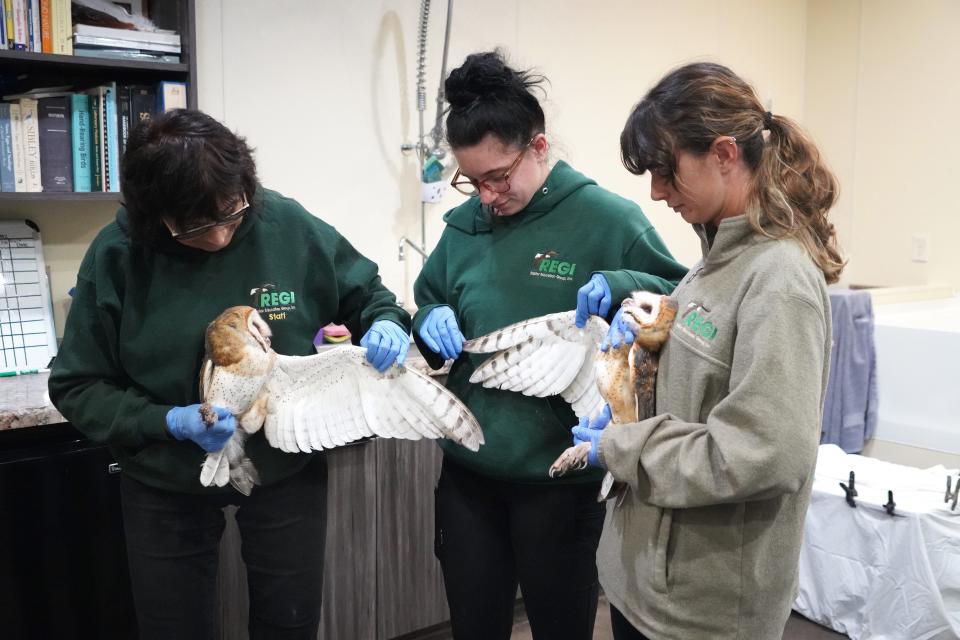
Gibson and her associates at REGI gave the birds final physical examinations Sept. 26. Feathers were checked for "stress bars," weak spots that can be caused by malnutrition and cause breakage; eyes and ears were assessed; weights were measured (1.19 pounds for the female, 1.08 for the male) and hearts and lungs were checked with a stethoscope.
Gibson pronounced the owls "raring to go."
On Oct. 1 they then became the definition of "precious cargo" when Gibson drove them, along with a ruby-throated hummingbird, black-and-white warbler, green heron and broad-winged hawk, to western Wisconsin for the next phase of their lives.
The barn owls were placed in an aviary, a 10 by 10 by 12 foot enclosure with two windows, where they are being acclimatized to the sights and sounds of the area.
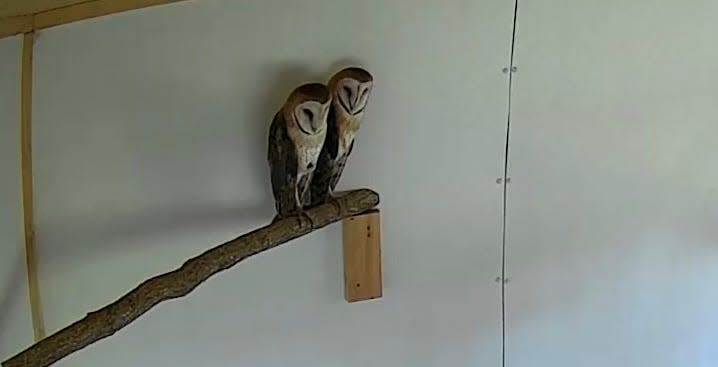
The structure is within "flying distance" of the birds' original nest, said Johnson, the veterinarian.
She and Bloem of the owl center are watching and caring for the birds. A video camera in the aviary provides images of the owls around the clock.
So far, so good, said Johnson. The owls are eating well, flying and splashing in a small pool in the enclosure.
If all goes according to plan, sometime later this month the windows will be opened and the birds will be allowed to fly out. Food will continue to be provided in the aviary if they want to come back during a transition to the wild.
Or they can go off on their own and live the mostly secretive life they were born to.
"It's an exciting time for these birds and for the species in Wisconsin," Johnson said. "These two young ones could be part of a new wave of this secretive, charismatic breed in our state."
Support barn owls
Wisconsinites can support the barn owl population by reporting observations, leaving up dead trees when safe to do so, and refraining from using pesticides and rodenticides.
Report barn owl sightings to Wisconsin eBird or by using the DNR’s rare species reporting form.
Our subscribers make this reporting possible. Please consider supporting local journalism by subscribing to the Journal Sentinel at jsonline.com/deal.
DOWNLOAD THE APP: Get the latest news, sports and more
This article originally appeared on Milwaukee Journal Sentinel: Young barn owls are rehabilitated and on course to be released to wild

